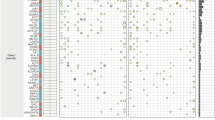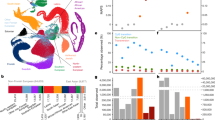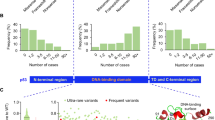Abstract
Molecular biologists are increasingly faced with the problem of assigning a function to genes that have been cloned. A new approach to this problem involves the manipulation of the cloned gene to create what are known as 'dominant negative' mutations. These encode mutant polypeptides that when overexpressed disrupt the activity of the wild-type gene. There are many precedents for this kind of behaviour in the literature—some oncogenes might be examples of naturally occurring dominant negative mutations.
This is a preview of subscription content, access via your institution
Access options
Subscribe to this journal
Receive 51 print issues and online access
$199.00 per year
only $3.90 per issue
Buy this article
- Purchase on SpringerLink
- Instant access to full article PDF
Prices may be subject to local taxes which are calculated during checkout
Similar content being viewed by others
References
Rebagliati, M. R., Weeks, D. L., Harvey, R. P. & Melton, D. A. Cell 42, 769–777 (1985).
Young, R. A. & Davis, R. W. Proc. natn. Acad. Sci. U.S.A. 80, 1194–1198 (1983).
Muller, H. J. in Proceedings of the Sixth International Congress of Genetics (ed. Jones, D.F.) 213–255 (Brooklyn Botanic Gardens, Menasha, Wisconsin, 1932).
Scherer, S. & Davis, R. W. Proc. natn. Acad. Sci. U.S.A. 76, 4951–4955 (1979).
Rothstein, R. J. Meth. Enzym. 101, 202–211 (1983).
Russell, P. & Nurse, P. Cell 45, 145–153 (1986).
Miller, B. L., Miller, K. Y. & Timberlake, W. E. Molec. cell. Biol. 5, 1714–1721 (1985).
May, G. S., Weatherbee, J. A., Gambino, J., Tsang, M. L.-S. & Morris, N. R. in Molecular Genetics of Filamentous Fungi (ed. Timberlake, W. E.) 239–251 (Liss, New York, 1985).
Smithies, O., Gregg, R. G., Boggs, S. S., Koralewski, M. A. & Kucherlapati, R. S. Nature 317, 230–234 (1985).
Thomas, K. R. & Capecchi, M. R. Nature 324, 34–38 (1986).
Izant, J. G. & Weintraub, H. Cell 36, 1007–1015 (1984).
Melton, D. A. Proc. natn. Acad. Sci. U.S.A 82, 144–148 (1985).
North, G. Nature 313, 635 (1985).
Rosenberg, U. B., Preiss, A., Seifert, E., Jäckle, H. & Knipple, D. C. Nature 313, 703–706 (1985).
Crowley, T. E., Nellen, W., Gomer, R. H. & Firtel, R. A. Cell 43, 633–641 (1985).
Nishikura, K. & Murray, J. M. Molec. cell. Biol. 7, 639–649 (1987).
Kim, S. K. & Wold, B. J. Cell 42, 129–138 (1985).
Rebagliati, M. R. & Melton, D. A. Cell 48, 599–605 (1987).
Bass, B. L. & Weintraub, H. Cell 48, 607–613 (1987).
Meeks-Wagner, D. & Hartwell, L. H. Cell 44, 43–52 (1986).
Blose, S. H., Meltzer, D. I. & Feramisco, J. R. J. Cell Biol. 98, 847–858 (1984).
Wehland, J. & Willingham, M. C. J. Cell Biol. 97, 1476–1490 (1983).
Feramisco, J. R. et al. Nature 314, 639–642 (1985).
Kung, H.-F., Smith, M. R., Bekesi, E., Manne, V. & Stacey, D. W. Expl. Cell Res. 162, 363–371 (1986).
Chandler, V. L., Maler, B. A. & Yamamoto, K. R. Cell 33, 489–499 (1983).
Swift, G. H., Hammer, R. E., MacDonald, R. J. & Brinster, R. L. Cell 38, 639–646 (1984).
Miller, J. H. in The Operon (eds Miller, J. H. & Reznikoff, W. S.) 31–88 (Cold Spring Harbor Press, New York, 1978).
Kelley, R. L. & Yanofsky, C. Proc. natn. Acad. Sci. U.S.A. 82, 483–487 (1985).
Matthews, B. W., Ohlendorf, D. H., Anderson, W. F. & Takeda, Y. Proc. natn. Acad. Sci. U.S.A. 79, 1428–1432 (1982).
Sauer, R. T., Yocum, R. R., Doolittle, R. F., Lewis, M. & Pabo, C. O. Nature 298, 447–451 (1982).
Hope, I. A. & Struhl, K. Cell 46, 885–894 (1986).
Wachsman, W. et al. Science 235, 674–677 (1987).
Waterston, R. H., Hirsh, D. & Lane, T. R. J. molec. Biol. 180, 473–496 (1984).
Fuller, M. T. in Gametogenesis and the Early Embryo (ed. Gall, J. G.) 19–41 (Liss, New York, 1986).
Kusch, M. & Edgar, R. S. Genetics 113, 621–639 (1986).
Park, E. C. & Horvitz, H. R. Genetics 113, 821–852 (1986).
Alberts, B. M. Cold Spring Harb. Symp. quant. Biol. 49, 1–12 (1984).
Wente, S. R. & Schachman, H. K. Proc. natn. Acad. Sci. U.S.A. 84, 31–34 (1987).
Robey, E. A. & Schachman, H. K. Proc. natn. Acad. Sci. U.S.A. 82, 361–365 (1985).
Gibbons, I., Flatgaard, J. E. & Schachman, H. K. Proc. natn. Acad. Sci. U.S.A. 72, 4298–4302 (1975).
Mitchell, A. P. Genetics 111, 243–258 (1985).
Almassay, R. J., Janson, C. A., Hamlin, R., Xuong, N-H. & Eisenberg, D. Nature 323, 304–309 (1986).
Johnston, S. A., Zavortink, M. J., Debouck, C. & Hopper, J. E. Proc. natn. Acad. Sci. U.S.A. 83, 6553–6557 (1986).
De Lozanne, A. & Spudich, J. A. Science 236, 1086–1091 (1987).
Author information
Authors and Affiliations
Rights and permissions
About this article
Cite this article
Herskowitz, I. Functional inactivation of genes by dominant negative mutations. Nature 329, 219–222 (1987). https://doi.org/10.1038/329219a0
Issue Date:
DOI: https://doi.org/10.1038/329219a0



